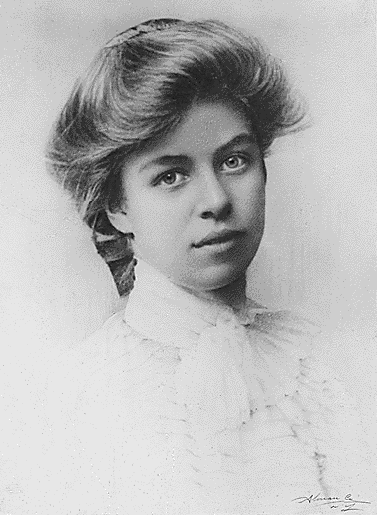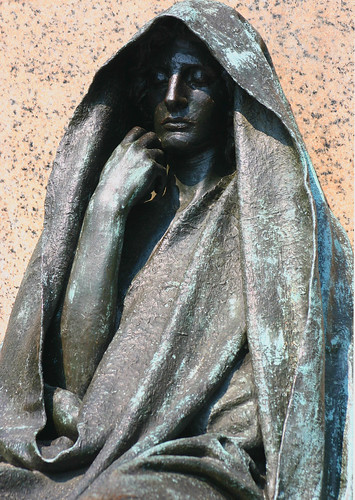
In the Rock Creek Cemetery in Washington D.C. lies the grave site of Clover Hooper Adams. This unique grave site bears an allegorical bronze sculpture representing despair and grief. It is not named, but does not ask to be named. This sculpture is the questioner.
 The story of Marian "Clover" Hooper Adams is complex and tragic. An outspoken, intellectual woman who was one of the earliest portrait photographers, fell into a deep depression after the death of her father in April 1885. In December of the same year in her bedroom, she drank potassium-cyanide, a poisonous chemical used in developing her photographs. To read more about Clover Adams, click here.
The story of Marian "Clover" Hooper Adams is complex and tragic. An outspoken, intellectual woman who was one of the earliest portrait photographers, fell into a deep depression after the death of her father in April 1885. In December of the same year in her bedroom, she drank potassium-cyanide, a poisonous chemical used in developing her photographs. To read more about Clover Adams, click here. Henry Adams, Clover's husband, traveled to Japan with La Farge in 1886 to learn about Buddhism. The next year he commissioned Augustus Saint-Gaudens to create a memorial for his wife. He was specific about the need for the sculpture to be a union of Eastern and Western spirituality . Saint-Gaudens became deeply involved in the piece and casting was postponed a few times. The piece was finally unveiled in 1891, four years after the commission had been made. Wikipedia offers more on the story.
 The piece was never officially named. Saint-Gaudens meant for the statue to ask a question, not to answer one. The sculpture is not meant to be male or female, nor is it meant to be a monument to suicide. I believe this piece was meant to speak to the soul, to awaken people to the concept of life and death, and to move something inside them. Eleanor Roosevelt was known to visit the sculpture often, and said that when she was feeling unhappy, she would visit the statue and come away feeling better and stronger. For more information read the article In the Statue's Grip.
The piece was never officially named. Saint-Gaudens meant for the statue to ask a question, not to answer one. The sculpture is not meant to be male or female, nor is it meant to be a monument to suicide. I believe this piece was meant to speak to the soul, to awaken people to the concept of life and death, and to move something inside them. Eleanor Roosevelt was known to visit the sculpture often, and said that when she was feeling unhappy, she would visit the statue and come away feeling better and stronger. For more information read the article In the Statue's Grip. 
Mark Twain visited the statue in 1906. He is rumored to have named the statue "Grief" which in my opinion seems like a fitting title for the piece. This is mentioned in The Legend of Black Aggie. However, I think the statue can hold many names for the different people who view it. It is such a compelling piece of art and it can help us understand that our suffering doesn't go unnoticed.
 Augustus Saint-Gaudens is an incredible artist. His work is revered the world over, even by his competitors. For information on the video, American Masters: Augustus Saint-Gaudens, go to PBS.org. Throughout the next few weeks I will be discussing one or more of his sculptures, including the Shaw Memorial which you won't want to miss! Please feel free to leave a comment or to reply to this post. I welcome feedback and am interested in what you have to say.
Augustus Saint-Gaudens is an incredible artist. His work is revered the world over, even by his competitors. For information on the video, American Masters: Augustus Saint-Gaudens, go to PBS.org. Throughout the next few weeks I will be discussing one or more of his sculptures, including the Shaw Memorial which you won't want to miss! Please feel free to leave a comment or to reply to this post. I welcome feedback and am interested in what you have to say. 



-Penny Lane

Comments
Post a Comment